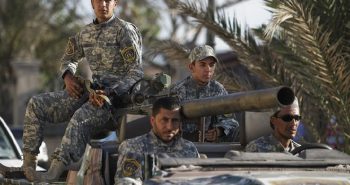By Jonathan Fenton-Harvey
 There are heightened fears that the Libyan civil war could increase terrorism in regional countries. While there was truth to this early on in Libya’s conflict, how much is Libya a regional security threat now?
There are heightened fears that the Libyan civil war could increase terrorism in regional countries. While there was truth to this early on in Libya’s conflict, how much is Libya a regional security threat now?
As Libya descends into a deeper civil war with no immediate end in sight, UN Secretary General Antonio Guterres has expressed fear that the conflict would spill over into neighboring countries, particularly the Sahel region, which has already faced grave instability.
“Libya has been a center, a cancer for arms export and fighters export … and the most worrying impact is of course with the Sahel and Lake Chad. And more and more these things are interlinked,” said Guterres in an Al Jazeera interview in Davos, Switzerland.
“What we are having with the Sahel and Lake Chad is a war with terrorist organizations that we are not winning. Terrorism is spreading. It is now threatening the countries of the coast – Ivory Coast, Ghana, Benin,” he added.
Libya has been in a state of turmoil since Gaddafi’s regime fell after the NATO-backed 2011 Libyan revolution, with rival factions subsequently vying for control of the country and its resources. Libya became awash with weapons and foreign fighters, with tribal and Salafist factions being key political players.
Regional countries have expressed worries about the regional risks. Algeria has tried to use its leverage to call for de-escalation and mediation in Libyan National Army commander Khalifa Haftar’s latest assault on the Tripoli-based Government of National Accord (GNA).
Tunisia has likewise shown concerns and fears a large refugee influx from neighboring Libya even as GNA prime minister Fayez al-Sarraj has speculated Haftar’s current offensive could create a major refugee crisis for Europe.
Meanwhile in the Maghreb region, both Tunisia and Algeria have fortified their borders, fearing greater security threats.
However, this was largely a factor early on in the conflict. From the beginning, Libya’s civil war had created a new opportunity for regional fighters crossing into the country.
Because of Libya’s initial instability following the post-Arab Spring regime change, there was a spillover of Libyan fighters into neighboring states.
“It is true that in July 2011, a substantial number of vehicles were used by Tuareg fighters to move lots of weapons [and] also lots of cash that had been given to them by the Qadhafi regime in order to fight on its side, but those seasoned Sahelian fighters decided to defect, cross Niger and go into Northern Mali,” Jalel Harchaoui, research fellow at Clingendael Institute, told Inside Arabia.
“This incident actually played a role in catalyzing the conflict in Northern Mali in 2012.”
Regional fighters had then entered the conflict through Libya’s weakened southern border with Chad.
Regional fighters had then entered the conflict through Libya’s weakened southern border with Chad. Along with increased smuggling networks of people and goods, Sahel militias had used it as a training ground. Many of whom had actually posed a great security threat to Libya.
“More broadly, from 2011 through 2018, Libya acted as somewhat of a safe haven wherein jihadi groups from the Sahel could come, regroup, raise funds, rest, buy weapons, etc.
Clearly here, it is legitimate to talk about the anarchy in Libya fueling the crisis in the Sahel, to some extent or other,” added Harchaoui.
Speaking to Inside Arabia, Tarek Megerisi, Libyan researcher at the European Council of Foreign Relations, said that nearby militias and extremists had chiefly used Libya’s chaos as an opportunity to gain more battle experience.
“The southern border had become very porous during Libya’s conflict, and Chadian militias have been able to come in, particularly in the early years after the revolution,” Megerisi said.
“After becoming a stronger threat from their time in Libya, they would return home and fight against their government.”
In effect, Libya had served as a sanctuary for foreign militias to gain more experience and carry out attacks at home.
“The West didn’t ask us our opinion when they attacked Libya,” Chad’s President Idriss Déby had publicly said. “They achieved what they wanted—the destruction of Libya, the death of Gaddafi,” he added, while reporting the instability it caused in his own country and the lack of responsibility taken by the NATO nations.
When the Islamic State in Libya gained success, from 2014 and 2016, the country had also served as a “training ground” for regional militants, mostly from Tunisia, who would later return to their country of origin or elsewhere in the region and carry out attacks.
Tunisia suffered multiple extremist incidents in 2015. Attacks on tourists in the Bardo Museum in Tunis in March that year, and later in June, in Sousse, killed dozens of vacationers.
The incidents devastated the country’s economy due to the subsequent loss in tourism revenue. The gunman responsible for the Sousse beach massacre which killed 38 tourists had reportedly been among those Tunisian foreign fighters training in Libya, prior to returning to his own country.
“Investigations show Saif Rezgui was in contact with terrorists in Libya and that he is likely to have trained in a Libyan camp,” said a Libyan security official.
Jihadist threats inside Libya have consistently weakened from 2016 until today after they lost a key base: the northwestern city of Sirte.
Jihadist threats inside Libya have consistently weakened from 2016 until today after they lost a key base: the northwestern city of Sirte. Although the current violence between Haftar and the GNA has arguably reduced its presence too, considering that neither side would want to see the faction growing.
“However, ISIS has still managed to maneuver in pockets amid the fighting, and with much of the violence focused in Tripoli, this could give them room to carry out further attacks,” said Megerisi.
Indeed, the UN in December still reported a noticeable level of foreign fighters operating in Libya.
France has backed Khalifa Haftar under the pretext of needing to create stability in Libya. Yet in Megeresi’s view, this is an absurdity as continued conflict could further risk spilling over into neighboring countries.
To be sure, the Sahel region has faced greater security threats and is more linked to the violence domestically. There are arguably other factors which have triggered the violence there.
Harchaoui notes that there is currently limited evidence of a flow of weapons and militias towards Libya’s southern border, and that claims from Guterres and others portraying Libya as a source of regional instability are exaggerated.
“Meanwhile, the jihadi groups have grown dramatically stronger in places like southern Niger, Burkina Faso, and Mali. Not only that, but jihadi strength has attained a critical mass, and reached a local momentum that makes it self-sustaining and self-reinforcing,” Harchaoui said.
“I see no reason to claim that, right now, the mess in Libya — which boils down to a nasty internationalized civil war involving little actual terrorism and no full-blown jihadi group — fuels the crises in the Sahel.”
“The Libya conflict is mainly centering in the Tripoli area and — if anything — we might witness jihadi groups move into that mayhem and take advantage of it within the next several months,” Harchaoui added.
According to Megerisi, though there is still a risk of fighting spilling over into the Sahel region, ending Libya’s internal conflict is a prerequisite to preventing such further security threats.
***
Jonathan Fenton-Harvey is a journalist and researcher focusing on conflict and geopolitics in the Middle East and North Africa region. He has particularly covered Gulf issues and Western foreign policy in the region, having delivered numerous talks and articles on these topics.
______________





